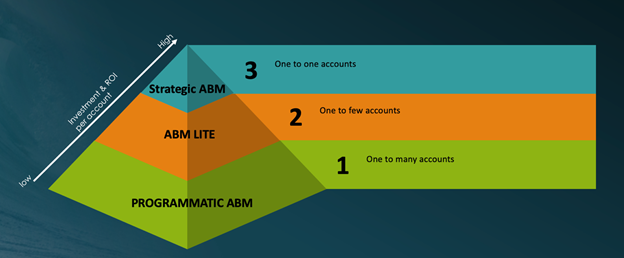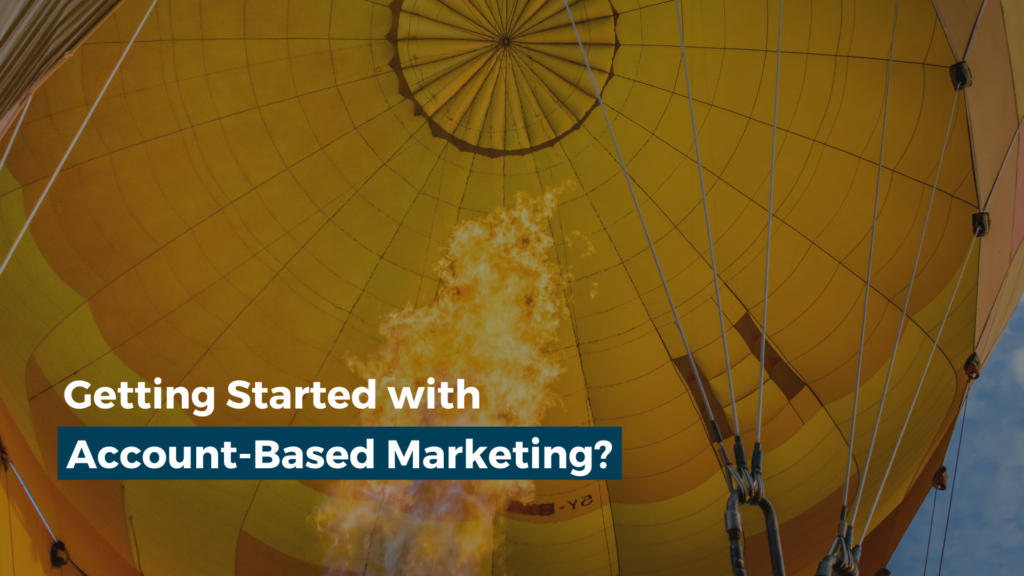Account-Based Marketing (ABM) is one of the most sought-after B2B marketing trends. Even though ABM is nothing new – it has been talked about since the early nineties. Put simply, it’s a form of B2B marketing that focuses on targeting fewer, high-value accounts, rather than trying to engage with many accounts.
What is Account-Based Marketing?
Account-Based Marketing is a targeted marketing strategy in which marketing and sales collaborate to target best-fit accounts and create a personalized buying experience with the products or services offered. Account-Based Marketing is nothing but hyper-personalizing marketing campaigns to individual prospects to treat every account as a market in themselves.
“Account-based marketing is a strategic approach to designing and executing highly-targeted, personalized marketing programs and initiatives to drive business growth and impact with specific, named accounts.”
– ITSMA
Account-Based Business Strategy helps to root out less-valuable businesses early on and maintain maximum synergy with marketing and revenue. It results in higher ROI with an increase in consumer satisfaction along with personalizing the purchaser’s path and tailoring all messages, content, and campaigns for those individual accounts. Additionally, it also helps further into the vital processes of engaging and delighting those accounts.
How is Account-Based Marketing different from Inbound Marketing?
Account-Based Marketing and Inbound Marketing are thought of as entirely different entities. Reason being: Account-Based Business Strategy is categorized as a sales strategy and inbound as a marketing strategy. Inbound has a wider approach and looks to attract a whole different range of prospects at different stages whereas ABM is much more specific.
Account-based marketing and inbound marketing have the power to make waves (the good ones) if implemented together. Inbound marketing is more fundamental, helping to attract consumers through the development of valuable, SEO-optimized content, and a pleasant customer experience. Inbound lays the groundwork for a powerful Account-Based Marketing strategy.
As a highly personalized strategy, Account-Based Marketing works to target specific company accounts and build relationships with ideal prospects within them. It is based on the proposition that within any account, there are multiple people involved who make the final purchase decision, so it is best if all those individuals are targeted with relevant content and ads, instead of blast campaigns.
Combining Account Based Business Strategy and inbound marketing, you can have the best of both worlds. Inbound marketing helps to gain target accounts, and ABM speeds up the flywheel to win and satisfy those target accounts with a remarkable customer experience.
Why Account-Based Marketing?
B2B sales cycle is complex. Gone are the days when sales reps could strike up a deal by identifying the key decision-maker within the organization. Any purchase decision is jointly made by anywhere between 6 to 15 stakeholders. Hence, an account-based approach seems to be the right decision for B2B marketers looking to target new leads and maintain relationships with established accounts.
The 2020 State of ABM Report shows 94.2% of respondents have an active ABM program (up from 77% in 2019) with mature ABM programs accounting for 79% of all sales opportunities (vs. inbound/outbound, etc.)
ABM works by bringing sales and marketing together to drive growth. By having common goals, marketing and sales can support each account through the entire buyer’s journey – from early phase awareness, through the research and evaluation phase, during the client’s decision making, and then, straight up to the after-sale by fostering trust and loyalty.
Benefits of Account-Based Marketing
Sales and marketing alignment
Aligned sales and marketing help to ensure all communications are consistent. This creates a seamless and delightful customer experience throughout their journey.
Better return on investment
Account-Based Business Strategy cuts down on resource wastage by focusing on target accounts. This Strategy helps to measure return on investment (ROI) for each account you invest your resources and time into.
Personalized customer experience
Insight on target accounts make it easy to deliver a personalized experience for them. Creating a personalized experience will help you better resonate with the target account’s pressing challenges and needs
Faster Sales Process
Account-Based Business Strategy provides an opportunity to nurture primary decision-makers particularly, along with all relevant potential customers, to facilitate and hasten the sales process.
Account-Based Marketing Approaches

STRATEGIC ABM: ONE TO ONE ACCOUNTS
One-to-One ABM is a strategic approach of treating valuable target accounts as an individual market and engaging with each of them in a bespoke way. With Strategic Account-Based Marketing, account teams create deeper partnerships through targeted marketing experiences with high-value clients.
With this approach, a dedicated, senior-level marketer works directly with one or a few strategic or key account teams on the sales side. And, crafts bespoke marketing plans and programs for each account as an integral part of the overall account plan.
ABM LITE: ONE TO FEW ACCOUNTS
One-to-Few ABM is a way of using one-to-one ABM principles and applying them at scale to a larger number of target accounts. It is also known as ABM Lite.
This is a one-to-few model, typically applied to groups of strategic and/or second-tier named accounts. With ABM Lite, marketing programs and campaigns are typically focused on small groups of accounts rather than individual accounts, usually 5-10 at a time, that share similar business attributes and challenges.
Collaboration with sales is focused mainly on key decision points, such as which accounts to target, which business issues to highlight, which propositions to promote, and how to tailor existing content for these one-to-few programs and campaigns.
PROGRAMMATIC ABM: ONE TO MANY ACCOUNTS
One-to-Many ABM is scaling by applying ABM principles to a larger number of target accounts. It is also known as Programmatic ABM.
Marketing and sales can create larger account lists and scale their campaigns using mar-tech to personalize outreach.
With Programmatic ABM, marketing shifts its traditional focus from generating, nurturing, and tracking leads by an individual to an account-based view. A one-to-many approach is possible due to the latest technologies that enable razor-fine targeting, analytics, and personalization across hundreds or even thousands of identified accounts.
Companies use Programmatic ABM to target specific segments such as horizontal or vertical markets or other groups of named accounts selected from across an overall market. Programmatic Account-Based Marketing is suitable if you want to increase brand awareness and create engagement at key accounts.
Five steps to getting started with Account-Based Marketing
I. Select your target accounts
Account-Based Marketing is all about combining sales and marketing efforts on a relatively small number of high-value accounts with greater revenue potential. This makes account selection a crucial aspect of any Account-Based Marketing program. The objective of the account selection process is to optimize sales and marketing resources by focusing on accounts most likely to drive revenue.
The first step in account selection is defining the Ideal Customer Profile (ICP). While building an ICP, it is important to consider factors like:
· Is the market growing?
· Which accounts do we already have a strong relationship with?
Selecting target accounts
Fundamentally, two key factors are considered while selecting accounts:
Fit: To define an ICP and prioritize accounts
· Firmographic includes: Company size, number of employees, industry growth, number of locations
· Technographics includes: Complementary technologies to yours and technology that rules out your solution or makes investment less likely
Interest: To measure and prioritize accounts
· Intent Data is an online behavior-based activity across the internet including third-party websites.
· Engagement Data finds the level of interaction with target accounts including current and past activities.
These two dimensions combined brings together gut feel, historical performance, and sometimes predictive data science.
II. Identify people and insights
Since Account Based Business Strategy focuses on personalization, it emphasizes on building personas. Building detailed user personas will help in relaying messages relevant to that particular persona.
Different research shows that the average number of key stakeholders in decision-making is 12. This makes it even more important to contextualize personas and prepare for interacting accordingly.
Sales reps start with identifying TAM, qualifying leads, and move on to build an account plan. Most sales reps like to gather information on accounts and industries they are targeting.
– Account Insight is a 360-degree intel on accounts to give a deep-dive understanding of their priorities, challenges, and opportunities combined with firmographic and technographic data.
– Industry insight helps to uncover the trends and forces that are driving your target global industry forward.
For this, you’ll have to predominantly rely on secondary research: also known as desk-research. Pull information like challenges and trends of a particular industry, as well as collect relevant news from influencers within the industry.
“More you know, the better, as then the more tailored and relevant the content will be.”
A good second step will be to map out the decision-making unit of your target account. Each role has its own set of responsibilities and challenges and has a say in the decision-making process. So, creating content that appeals to them individually will give them a better chance of success. Gather as much information as you can on the personas, look at their social media profiles, look at any news stories or press releases. One of the biggest challenges is to scale your insight generation efforts appropriately, so you can focus your efforts where they’ll make the most impact.
III. Generate relevant messages and content
One of the primary use of the insight generated is to create content that will be super-relevant to the key people inside your target accounts. The insight generated becomes an asset only if used effectively while interacting with key people. Every messaging and content has to be tailored and relevant for resonance.
The idea is to try different tactics and formats to engage with the target audience. Some personas read blog posts, while others would rather watch webinars. Every kind of content used in a normal sales and marketing process will be effective — as long as it’s targeted and relevant.
McKinsey & Company found that personalized engagement reduces acquisition costs by as much as 50% and increases revenues by up to 15%. Hence, Account Based Marketing content should be prepared by applying research about the persona and the company to prove that you understand their most pressing challenges and how you can help solve them.
IV. Instrument account-focused campaigns
Implementation is key to any successful account-based strategy. For every Account-Based Marketing strategy, it is essential to combine and synchronize content with different interaction channels. Marketers need to ensure target accounts see and absorb customized messages coordinated through different campaigns and platforms.
The fastest path to launching orchestrated campaigns and driving strong results is to focus on marketing and sales development orchestration. If done efficiently, marketing instrumentation meeting of business goals through Account-Based Business Strategy action plan.
V. Measure success
Account-Based Business Strategy is principally a unique approach that requires different metrics. Account-Based Strategy implementation effectiveness can be measured through an account-centric lens only.
Ideally, we would always be able to measure Account Based Business Strategy using closed deals and revenue. It takes a long time to show results and one needs to be clear that the impact on revenue cannot be seen immediately.
While determining metric for Account-Based Marketing, the following factor needs to be considered:
· Return on Investment Deal size
· Sales cycle,
· Win rate
· Retention rate
Marketers should never forget that Account-Based Marketing is not just about the new pipeline but about the entire customer journey. So, metrics for each stage are required for revenue acceleration.
Why is Account-Based Marketing crucial to B2B sales?
92% of B2B marketers consider ABM “extremely” or “very” important to their marketing efforts.
– SiriusDecisions
B2B marketers saw an increase in average annual contract value of 171% after implementing their ABM strategy.
– ABM Leadership Alliance
More than 80% say that ABM outperforms other marketing initiatives.
– ITSMA
86% of marketing and sales professionals from B2B companies have begun using targeted account strategies.
– LeanData
B2B companies are always looking to expand, and for this ABM is a game-changer. Account-Based Marketing not only enables them to reach the right person but also empowers them to be more empathetic to the pain points that the accounts are experiencing. Account-Based Marketing reaches out to the net-new customers and nurtures them with personalized messaging to boost efficacy within B2B sales and marketing teams.
How to make Account-Based Marketing more human?
Be it in B2C or B2B, people buy from people. It’s a human thing! People prefer to talk to a human rather than some bot and would choose a zoom call rather than an email. With the growing use of technology for automation and efficiency, marketing is losing its human essence. Most of the Account-Based Business Strategy software misses out on hyper-personalization due to lack of human element, so it has become crucial to humanizing account-based marketing programs. A key question you should ask: Am I doing enough to hyper-personalize my approach towards each of my Account-Based Marketing Accounts?
A rightly done Account Based Business Strategy never misses out on the human element. It is more than just identifying the target audience, reaching them, and engaging in a personalized way. Account-Based Marketing is engaging at a personal level and delivering messages or insightful content that will be helpful for prospects.
Account-Based Business Strategy requires sales and marketing to be aligned. Salespeople and marketers always need to work toward creating meaningful and intimate connections with their future and present customers. Simple desk-research can reveal deep insight into your target accounts. Gathering insight would be a value-add for any organization adopting an Account-Based Marketing approach, or one that sells to other large businesses. Having a structured process in place to turn the little nuggets of insight into actionable insights can be the difference between the success and failure of your Account-Based Marketing program.
A survey conducted by DemandbaseMarketing Innovation Summit for B2B revealed that – 92% of B2B tech firms recognize the value of ABM, going as far as calling it a B2B marketing “must-have.”
Here’s how to humanize research and contribute to the Account-Based Marketing program:
Leverage information that is available publicly
Publicly available information from company websites, annual filings, and investor presentations can reveal deep insight into your target accounts. These findings can then be leveraged into actionable insights for personalizing your Account-Based Marketing Program, which in turn humanizes it. These small high-value insights can hyper-personalize all your outward communication. You can source information from other sources too, such as press releases, executive interviews, and social media sites.
Create a structured process to turn information into insight
Having a structured process in place to turn the firmographic and technographic data into a structured report format would be the next step in your efforts to leverage research. Build a custom template to structure the information: overview followed by company insight, industry insight, and key executive insight. After you have a template in place to collect actionable insights, you can start filling up the template with the insight you have collected from various sources. And now you have a profile on the target account or industry which you are chasing after.
Use the report to support Account-Based Marketing campaigns
Now that you have compiled a report on the target account or industry that you are chasing after, you can incorporate the report to support your Account-Based Marketing initiatives. Your Account-Based Marketing program is being supported with up-to-date and refined data and insight. This can help to achieve higher personalization levels with your targeted marketing programs.
ABM IN THE CHANGING B2B ENVIRONMENT
Marketing teams are now shifting across multiple industry verticals, pivoting their mindset away from ‘spray and pray’ strategies and adopting Account-Based Marketing methods that embrace software and machine learning to drive a more targeted, personalized campaign and reduce wasteful efforts significantly.
1. New buying behaviors and preferences
Customer conversations that would have once happened with salespeople are now increasingly occurring online. As a result, if an organization’s digital presence and content aren’t strong, they risk being out of the consideration race before sales are even invited in. Upon being brought into the buying process, the sales interaction itself must also step up a level to go ‘beyond the brochure’ and add more strategic value to a highly informed customer.
2. More customer-facing channels and functions
Although salespeople have been the CEO of the consumer relationship in the past, consumers are now traversing a much wider variety of platforms, so this relationship can no longer be solely owned by sales. To ensure a consistent customer experience and provide efficient support during the purchaser’s journey, closer integration of customer-facing functions is required.
3. More digital interactions and data than ever
The abundance of online content has provided the user with a huge data advantage. Digital interactions have given more information than ever before to companies about what their consumers are doing and thinking about. To be more valuable to consumers and better prepared to advance purchasing possibilities, sales need to be empowered with this knowledge, as well as the skills needed to exploit these insights.
4. The need to do ‘more with less’
With many companies facing cost pressures, executives face the distinct challenge of achieving growth and enhancing the consumer experience, all while reducing revenue and service costs at the same time. To realize these advantages, a complex collection of trade-offs and careful changes to the channel mix are needed.
5. Changing competitive dynamics
With end-to-end consumer experience increasingly deciding the outcome of the sales process, more rapidly than the competition, the race is on to turn the company around the customer. Organizations need to adapt for their consumers while keeping ahead of both conventional rivals and non-traditional, disruptive new entrants.
Conclusion
Account-Based Marketing is a game-changer for B2B marketing and sales. It is all about identifying who your most important accounts are. A well-thought Account-Based Marketing strategy concentrates only on a few target accounts and not on markets or industries. Account-Based Business Strategy does require as much insight into your accounts as possible. Insights will allow marketers to craft content and campaigns optimized for the target accounts. Since Account-Based Marketing is not a one size fit all solution and requires a much deeper level of personalization, customized content, and engagement than almost any other form of marketing.
Ready to get started with research for your Account-Based Marketing campaigns? Let’s chat.


